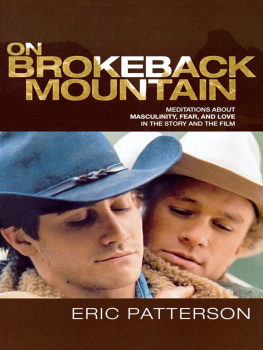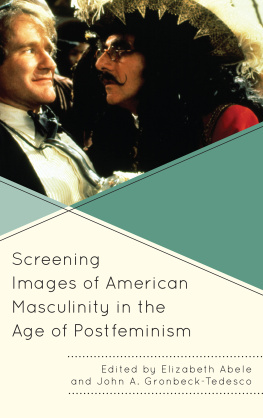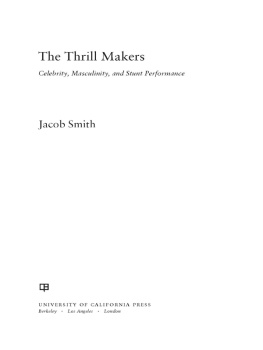Conclusion: Returns, Renewals, Departures
Through the actor and film case studies examined in this book, male angst is presented as a performance on two levels. First, angst is revealed as a frown, a concave expression, sad eyes, trembling hands, or a contorted face: a gesture, a series of movements, a sequence of sounds. Second, angst is evident as the breakdown of male social roles: the failure to be a traditional father and the necessary revision of the father image; the acknowledgement that men can be both hard and soft; or the realisation that the aging process calls for a reassessment of what it means to be a man. The chapters examine the performative nature of male identity by exploring the images and enactments of male angst that have frequently appeared in American films in the last two decades. The book not only considers the ways in which male instability has been performed both on and off screen but also reveals the constructedness of normative masculinity itself an image consolidated and disseminated by the media. Overall, this book problematises notions of a quintessential crisis of masculinity as epitomised by a select handful of actors or encapsulated by a specific film. Instead, the films and actors I discuss offer a miscellany of performance styles and demonstrate multiple tropes of male angst.
Throughout, the book performance has been considered in three main ways. First, performance describes the overall presentation of actions, whether via a film in a variety of contexts, an appearance on a talk show, or the delivery of a political statement to an audience. Second, performance refers to specific enactments, the methods used to present a character, the sign vehicles, physical and vocal gestures employed to create meaning. Finally, I have considered performance as a gendered enactment, perceiving masculinity as that which is put on a social role that is informed by cultural expectations. All three elements highlight the need to contextualise performances, locating them in social, cultural and historical terms, in order to make sense of the actions presented. The chapters illustrate how on-screen performances of male instability not only reflect the social and cultural moment in which they are situated but also feed back into the discourse, becoming part of the mediated process through which understandings of gendered identity are constructed.
Andrew Klevan has argued that it is only in the detailed investigation of select sequences in films that real meaning can be revealed. Concentrating on a sequence or a succession of sequences from each film, he observes, directs our attention to the moment-by-moment development of the performances, and he argues that a comprehensive analysis of sequences brings out the relationship between appreciating a performance and understanding a films meaning as it develops. This book, on the other hand, recognises the cinema screen as only the starting point in understanding performance.
The films and actors discussed in the book problematise the proposition that male power operates according to cycles of crisis and resolution, emphasising crisis over resolution or wholly denying the possibility of stability. At the end of About Schmidt, for example, it is implied that Schmidt has decided to take responsibility for himself and grow up. Yet Schmidts unreliable narration throughout the film making repeated claims for change that he fails to follow through suggests a resolution to his crisis is far from imminent. However, Schmidt has learned how to perform; realising the futility of his persistent complaining, he learns to appease his daughter by pretending to accept his new in-laws. Part of the process of Schmidt acting his age involves recognising how a father should perform when giving his daughter away at her wedding, even if the speciousness of his performance is clearly perceptible.
Similarly unresolved, in Lost in Translation Bob Harris returns home, leaving Charlotte in Tokyo and their blossoming romance unconsummated, to resume his life as a father who forgets his childrens birthdays, puts his work commitments before his family and remains detached from his wife. Bobs trivial attempts to change requesting light meals at home instead of takeaways are too inconsequential to suggest his identity crisis will be resolved any time in the near future. In Broken Flowers, after his unsuccessful attempts to find his son, Don Johnston returns to the solitude of his sofa, no closer to revealing the identity of the person who sent him the letter informing him he is a father. A close-up of a bunch of wilted roses underscores his inability to take care of himself, not to mention a dependent. The ending of Magnolia offers only a provisional solution to Frank Mackeys angst. Cruises character does finally manage to weep for his father and, in going to meet his stepmother for the first time, the film suggests that Mackey might now be able to forge a normal connection with the opposite sex. But the strength of his misogyny as displayed in the Seduce and Destroy seminars undermines the possibility of change. There is no indication that he understands the destructive nature of his misogynistic identity, and no way to tell whether he will now attempt to adapt or reject this restrictive personality.
Many of the actors discussed have continued to play angst-ridden characters in Hollywood, underscoring the importance of considering screen persona alongside screen performance. In Edmond (2005), the film version of David Mamets stage play, the eponymous protagonist is again played by William H. Macy who builds on Johns verbal and physical implosion in Oleanna. Macy portrays a nervy businessman who, after being told by a tarot card reader You are not where you belong, leaves his wife and viciously murders a young waitress after they have sex. In The Bucket List (2007), cancer patients Jack Nicholson and Morgan Freeman refuse to equate aging with decay and deterioration by doing all the things they wished they had done in their youth. The conclusion sees Nicholsons womanising character decide to act his age and attempt to rebuild his relationship with his estranged daughter. In May 2008, the importance of family values, and the father as role model, once again became a contested topic of debate in Hollywood, when Bill Murrays wife and the mother of four of his children filed for divorce, citing abusive behaviour, adultery, family abandonment and drug addiction. Days later on The Ellen DeGeneres Show, Will Smiths performance of responsible fatherhood in The Pursuit of Happyness extended past the cinematic stage when he emphasised the importance of the two-parent family unit, stating that for him and wife Jada Pinkett Smith, Divorce is not an option. In each case, the performance of male angst as both physical expression and social role involves more than an isolated screen performance and blurs the line between person and persona, actor and character.
Referring to the complex and ambiguous nature of performance signs and the differing ways the term has been adopted by a variety of academic disciplines, Marvin Carlson has argued that performance by its nature resists conclusions. Indeed, the boundaries of performance appear to be limitless, crossing multiple media platforms, genres, actors, and personalities. However, there is also much to gain by considering films and actors in terms of performance, that is, in conceiving performance as a multifaceted idiom comprised of discrete yet interrelated elements. Performance, as I have shown, can be a style, a gendered act, a social action, with or without intention, practice or repetition, enmeshed in the fabric of the wider culture, not separate from it. This book establishes that meaning is most fully realised when taking into account the complex and often contradictory network of factors affecting performance, presenting performance as much more than a sequence of gestures and sounds.






